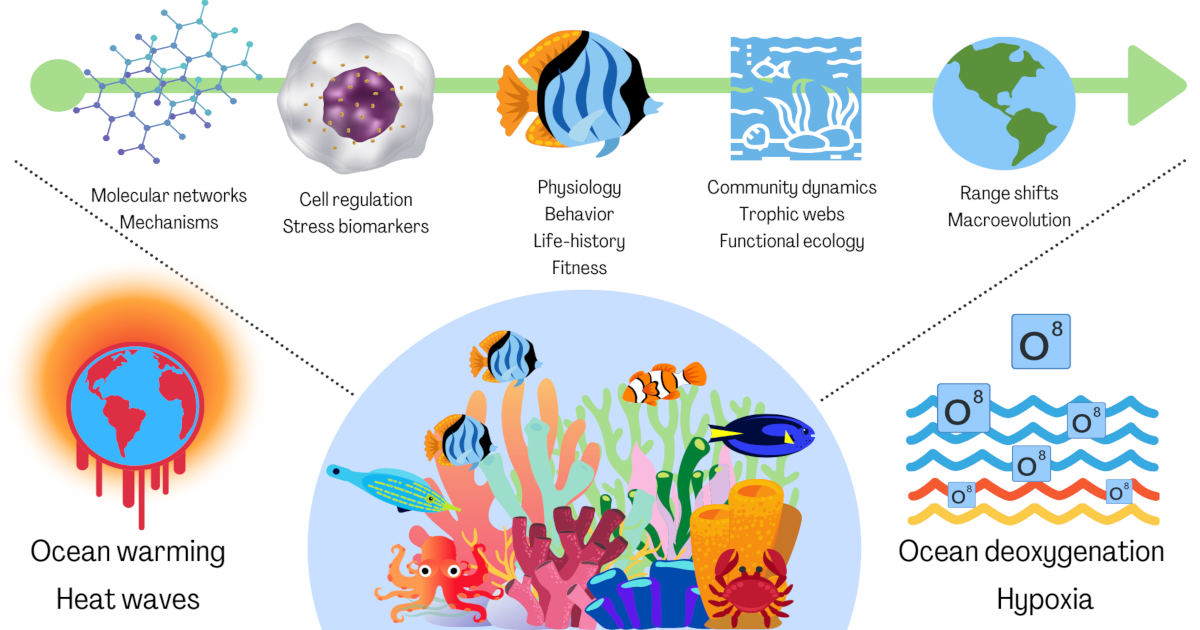Thermal and Hypoxia Vulnerability in Tropical Marine Systems: Advances in Physiology, Ecology and Evolution
A special issue of Journal of Marine Science and Engineering (ISSN 2077-1312). This special issue belongs to the section "Marine Biology".
Deadline for manuscript submissions: closed (10 January 2022) | Viewed by 15076

Special Issue Editors
Interests: systems-biology; macroevolution; animal physiology; climate change; experimental biology; omics; biomarkers; marine conservation; marine ecology; tropical biology
Interests: marine ecophysiology; ocean acidification; temperature-dependent hypoxia; ocean deoxygenation; marine invertebrates; tropical biology; global change biology
Interests: comparative and evolutionary physiology; macrophysiology; developmental biology; thermal biology; ocean acidification; hypoxia; acid-base balance; osmo-ionic regulation; global changes biology
Special Issue Information
Dear Colleagues,
In the tropics, oceans are rapidly warming (OW) and marine heat waves (MHW), as well as hypoxia, are becoming more frequent, more severe, and longer-lasting. The impact these phenomena have on marine life depends on i) the multilevel hierarchical nature of physiological responses, ii) the complexity of genotype–phenotype–environment interactions, iii) organisms’ ability to buffer changes through behavior, iv) the plastic, epigenetic, and evolutionary trajectories of species and their ability to rapidly adapt to changes, and v) indirect impacts mediated by changes in species interactions and community structures and dynamics. In this Special Issue, we aim to investigate these processes in depth and create a useful critical synthesis, by bringing together cutting-edge original studies that assess the emerging risks of chronic and extreme warming and hypoxic events for tropical biotic systems. Innovative approaches in theoretical biology, field observations, experiments, and modeling, coupled to the investigation of pathways defining responses from cells to communities, are expected to enable significant improvements in our ability to predict the susceptibility of differing marine taxa phenotypes to global changes.
The target is tropical marine biotic systems, and the scope and potential topics include (but are not limited to):
- Field gradient studies and in situ transplant experiments testing the implications of local adaptation on organisms’ sensitivity to OW, MHW, and hypoxia;
- Laboratory selection experiments testing organisms’ scope for plastic and adaptive responses to OW, MHW, and hypoxia;
- Mesocosms experiments testing OW, MHW, and hypoxia effects on community composition and structure in tropical reefs, mangroves, seagrass meadows, and other tropical coastal habitats;
- Characterization of the molecular networks and metabolic pathways of tropical organisms under thermal and hypoxic stress via using -omics approaches;
- Comparative approaches to define the thermal and hypoxia vulnerability (physiological, developmental, life history, ecological, behavioral) of tropical life stages, populations, and species;
- How the relationship between sub-lethal stress (e.g., determined by biochemical markers) and organisms’ performance varies under thermally and oxygen-stressful scenarios for different taxa;
- Evolution of genetic, phenotypic, and ecological traits of organisms under thermal and oxygen changes;
- Paleoenvironmental approaches to OW, MHW, and hypoxia as drivers of marine mass extinctions (through integrating the fossil record with current species observational and experimental data);
- Theoretical and conceptual approaches to OW, MHW, and hypoxia impacts in marine ecosystems’ functional and structural connectivity;
- Uni- or multifactor modeling approaches projecting climate-driven changes (OW, MHW, and hypoxia) in species’ range shifts and how the use of different models affects the assessment of species thermal and hypoxia vulnerability.
Dr. Carolina Madeira
Dr. Noelle Lucey
Dr. Piero Calosi
Guest Editors
Manuscript Submission Information
Manuscripts should be submitted online at www.mdpi.com by registering and logging in to this website. Once you are registered, click here to go to the submission form. Manuscripts can be submitted until the deadline. All submissions that pass pre-check are peer-reviewed. Accepted papers will be published continuously in the journal (as soon as accepted) and will be listed together on the special issue website. Research articles, review articles as well as short communications are invited. For planned papers, a title and short abstract (about 250 words) can be sent to the Editorial Office for assessment.
Submitted manuscripts should not have been published previously, nor be under consideration for publication elsewhere (except conference proceedings papers). All manuscripts are thoroughly refereed through a single-blind peer-review process. A guide for authors and other relevant information for submission of manuscripts is available on the Instructions for Authors page. Journal of Marine Science and Engineering is an international peer-reviewed open access semimonthly journal published by MDPI.
Please visit the Instructions for Authors page before submitting a manuscript. The Article Processing Charge (APC) for publication in this open access journal is 2600 CHF (Swiss Francs). Submitted papers should be well formatted and use good English. Authors may use MDPI's English editing service prior to publication or during author revisions.
Keywords
- comparative and evolutionary physiology
- ecology and evolution
- conservation physiology and biology
- developmental biology
- thermal biology
- behavioral ecology
- community ecology
- theoretical biology
- biogeographical and evolutionary modeling
- global changes
Benefits of Publishing in a Special Issue
- Ease of navigation: Grouping papers by topic helps scholars navigate broad scope journals more efficiently.
- Greater discoverability: Special Issues support the reach and impact of scientific research. Articles in Special Issues are more discoverable and cited more frequently.
- Expansion of research network: Special Issues facilitate connections among authors, fostering scientific collaborations.
- External promotion: Articles in Special Issues are often promoted through the journal's social media, increasing their visibility.
- Reprint: MDPI Books provides the opportunity to republish successful Special Issues in book format, both online and in print.
Further information on MDPI's Special Issue policies can be found here.





